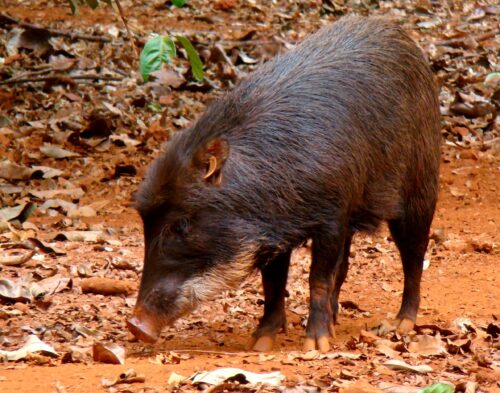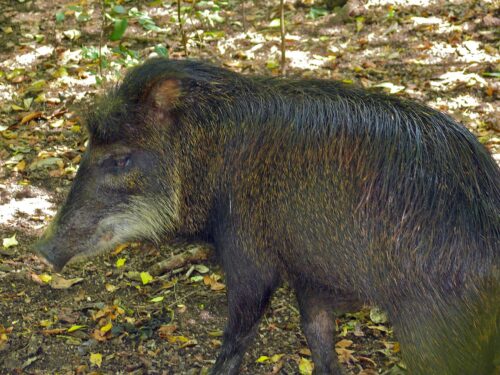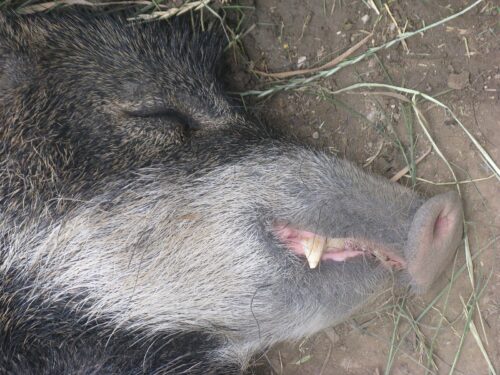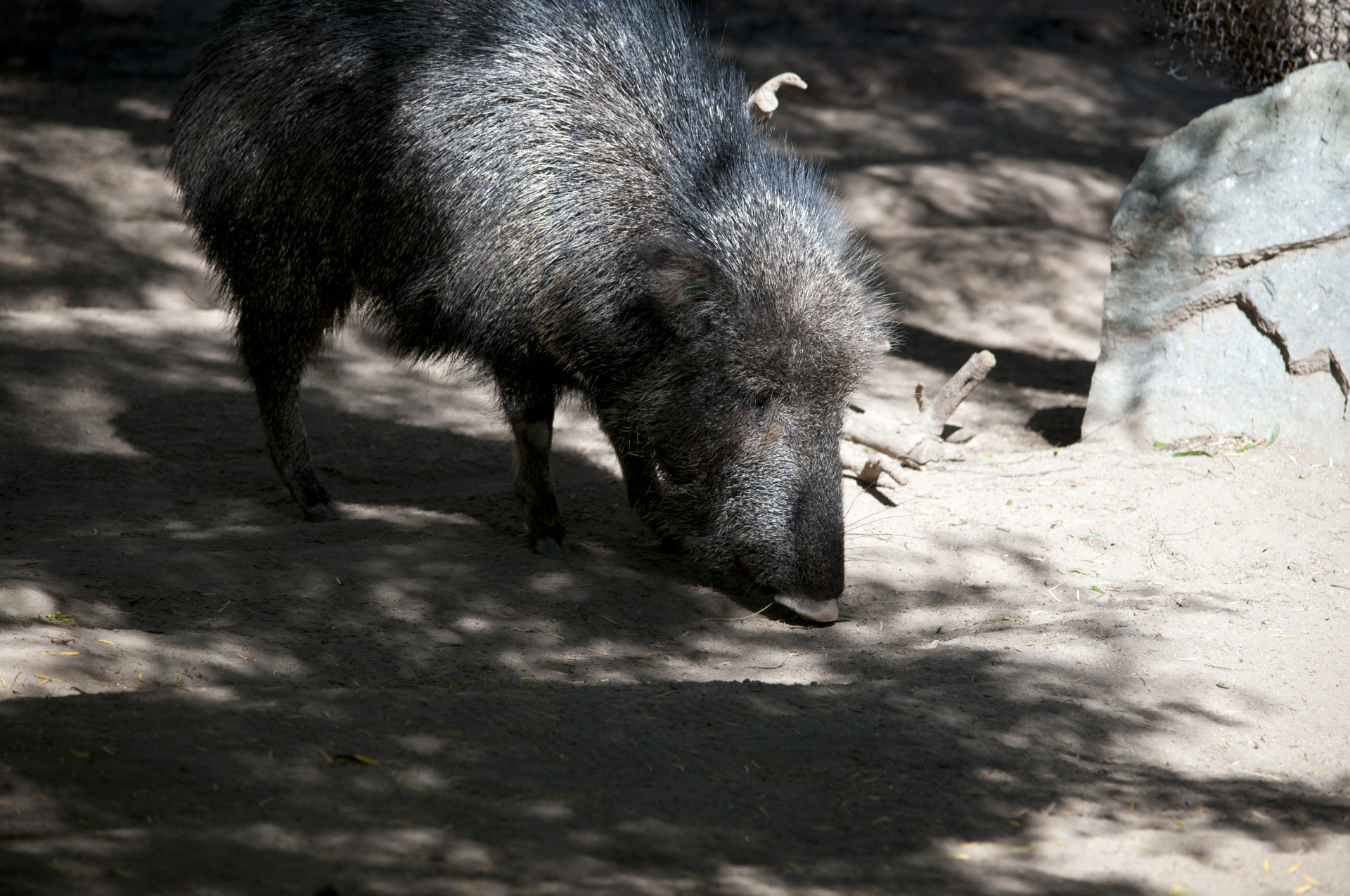How many species of Peccaries are there in Costa Rica?
Second Part.
White-lipped Peccary (Tayassu Pecari)

Names: Sometimes listed under the genus Dicotyles. Both parts of the scientific name come from the Brazilian Tupi language. Tayassu means taya gnawer. Taya are bulbs of plants in the philodendron family. Pecari means path maker. Spanish: Chancho de monte.Range: Southern Mexico to northeastern Argentina; from sea level to about 1,900 m (6,200 ft); mostly in large areas of pristine, wet forest, often near water. It has also been recorded in seasonally dry habitats and savannas in Guanacaste (although it is now extinct in that region) and parts of South America.
Size: 100 cm, 30 kg (40 in., 66 Ibs).
Similar species: The collared peccary shoulder collar, and lacks stark white fur on it Note, however, that the collared peccary can be around its face, and that the amount of white on can vary; a few have virtually none, while others down to their legs and belly. The collared peccary smaller herds, is less noisy, and, where the two tend to frequent drier, higher ground.
Natural history: Until recently, almost all that’s known of the behavior of white-lipped peccaries in the wild was based on studies done in the Amazon. Over the last few years, however, research conducted by Mariana Altrichter and colleagues in Corcovado has revealed details of the species natural history in Costa Rica

White-lipped peccaries are active by day or night. In Corcorado, they are mostly dhurnal, usually foraging in the early morning and late afternoon and resting between about 10:00 am and 2:00 pm.
They feed on fruits, seeds, stalks, leaves, insects and other animals, roots, tubers, and, occasionally, fungi and Blowers, all of which either take off the ground or dig up. Both in the Peruvian Am and in Corcovado, Costa Rica, whitelip feces contain about two-th fruit and seed remains and one- third vegetation remains. Favorite and seeds in Corcovado include those of the Moraceae family such as trees (Brosimum spp) and figs (Ficus spp.), as well as hog plums (Spondias spp), the kapok relative Quararibea asterolepis, wild cashew (Anacardium excelsum), camarón (Licania operculipetala), legumes (Inga spp.), and palms, including coyolillos (Astrocaryum spp.) and yolillos (Raphia taedigera).
Although Altrichter found the Astrocaryum palm seeds to be the peccaries’ favorite food during March and April, Corcovado’s whitelips do not feed nearly as heavily on palms as do whitelips in the Amazon.
This is curious, because the whitelips’ association with palms (such as Iriartea, Astrocaryum, and Euterpe) in the Amazon is considered fundamental to their ecology there.Palm seeds are eaten by relatively few vertebrates because they are extremely hard and because they appear in massive but patchy and seasonal crops that few animals can exploit efficiently. The design and behavior of white-lipped peccaries enable them to deal with both problems much more effectively than other fruit- and seed-eating mammals, including even their close relatives, the collared peccaries.

Peccary expert Richard Kiltie has calculated that a different jaw design gives whitelips a biting force at least 1.3 times that of collared peccaries, and thus the ability to eat harder seeds. And unlike collared peccaries (or any other Neotropical mammal) whitelips travel in huge herds typically containing between 50 and 100, and occasionally as many as 300 individuals that seldom stay long in one place, wandering up to 10 km (6 mi) each day and covering vast home ranges of between 4,000 and 20,000 ha (10,000 and 50,000 A).
This behavior is well suited for exploiting the massive but scattered palm crops.
Since palm seeds are tough (and not necessarily very nutritious either), it is possible that whitelips only exploit them heavily in the face of competition with certain other animals. Perhaps, as Altrichter has speculated, whitelips eat fewer palm seeds in Corcovado because competition is less intense than in the Amazon. Collared peccaries, for example, appear much less common than whitelips in Corcovado.
Animal matter appears to be eaten by whitelips only occasionally in some areas, but is a major component of the diet in others. Turtle scientist Archie Carr claimed that «where (white-lipped) peccaries passthere are almost no small ground-dwelling animals to be found,» and that herds regularly plundered beaches of turtle eggs, and, especially, hatchlings waiting to emerge just beneath the surface. In Peru, whitelips were found to feed on significant quantities of snails, millipedes, worms, and, occasionally, birds. In Brazil, a herd spent two months foraging almost exclusively on eels and other fish that were exposed as a pond dried up, and one individual even snaffled up a snake. And in Corcovado, Altrichter discovered that whitelips spend about one-third of their time digging, mainly to feed on earthworms.
It’s hard to tell if a peccary eats earthworms, because the worms may be indistinguishable to anyone watching peccaries feed, and are not detectable in stomach or fecal samples. Only by comparing soil samples was Altrichter able to gauge the importance of earthworms in the diet of her peccaries. Soil right next to where the peccaries excavated contained far more earthworms than soil collected at random from elsewhere, and also far more than the actual spot where the peccaries had been digging.

In other words, the peccaries selected spots with lots of worms and ate the worms as they dug.
Earthworms are not the only food that whitelips dig for. In some dry areas in South America, whitelips feed heavily on roots. They also unearth seeds and seedlings. Richard Kiltie has noticed that whitelips often dig around the bases of plants and logs and has suggested that such areas would be a good place to look for small stashes of seeds hoarded by rodents. In light of Altrichter’s new discovery, one wonders if such spots aren’t also good for worms.
Many of the white-lipped peccary’s foods are seasonal. Most plants only fruit once a year, and, in Corcovado, relatively few do so in the late wet season. Worms, on the other hand, become virtually inaccessible during the driest months, because the ground becomes too hard for the peccaries to rake, and because the worms are deeper in the soil.
Vegetation, however, is available all the time. In Corcovado, whitelips feed on the leaves and stalks of heliconias and philodendrons throughout the year, and especially in the late wet season, when fruits and seeds are most scarce. Philodendrons are an interesting choice, because they are unpalatable to most other animals. Peccaries may select them because they are rich in certain minerals. Nutritional analyses have shown, for example, that whitelips in Corcovado greatly increase their intake of calcium during the wet season by feeding on dumb cane philodendrons (Dieffenbachia spp.). This period coincides with their reproductive season, when pregnant or lactating females are most in need of calcium. This is also the time of the year when peccaries eat the most worms. Unlike most other whitelip foods, worms are full of protein, which is also especially important to mothers and their growing young.The foods available to whitelips in Corcovado vary not only through time but also in location, so whitelips need to move around with the different seasons. Altrichter found that, during the dry season, when the forest there offers the most fruits and seeds, whitelips stay inland, mostly in primary forest. As the wet season progresses and fruits and seeds become scarcer, they spend more time in secondary habitats (where heliconia leaves and stalks are always available), and along the coast (where, at that time of year, camarón fruits are available). As fruits and seeds become scarcer, whitelips also have to move around more to find enough food, much as collared peccaries do in Guanacaste (see p. 311). At the end of the wet season, Altrichter’s peccaries left her study area entirely.
Whitelips have an exaggerated reputation for ferocity. The large herds can make terrifying noises and may charge if threatened, but months of observations by biologists have revealed that they generally run away from perceived threats. Lyle Sowls, who has spent nearly 40 years studying peccaries, noted that during extensive observations at a bait station in Brazil, individuals occasionally threatened him by jumping a short distance in his direction, but invariably backed down if he walked purposely toward them. In the case of a stampede, climbing a tree is the safest escape strategy. If a climbable tree is not at hand, standing still may help since peccaries have poor vision. The only person (as far as is known) who has tested this theory, however, was bitten.
Whitelips in Corcovado mate between January and March. A gestation period of about five months results in one to three young, but most often twins. Young are reddish brown at birth. They gradually darken during their first year, turning black like the adults by the time they are about one-third grown, in their second year. Females and young tend to travel in the center of herds, while males spread out along the edges. Females reach sexual maturity at about a year and a half.
Genetic studies suggest that females tend to stay in their natal herds, while males leave and join other herds. These herds may not be far away, since whitelip herds have broadly overlapping home ranges and occasionally even forage within sight of one another. Captive whitelips can live at least 13 years.
Sounds: Retching noises by young; low rumbles, loud barks, and whines help herd members stay together or find one another when separated; grumbles, snorts, and tooth clacks are alarm noises or threats. While collared peccaries emit a series of three to eight tooth clacks, white-lipped peccaries usually emit single clacks.
Conservation: White lipped peccaries are indicator species, being among the first mammals to disappear when pristine habitats are disturbed by humans. Their foraging style requires large areas of forest, their meat is highly prized, and their large herd size makes it easy for hunters to kill many at a time. They may also be considered pests in some areas, for they occasionally raid crops of yuca, camote, corn, bananas, and sugar cane. The species is already extinct through most of its former range in Costa Rica, and is now seen regularly only in Corcovado National Park. Even there, whitelips are hunted extensively, especially in the late wet season when their migrations take them to the edges of the park and beyond.
The absence of such a large and formerly numerous mammal undoubtedly has tremendous repercussions on ecosystems. Whitelips were found to be the most important single food of the jaguar in Corcovado, for example, and their elimination from other areas has probably contributed to the jaguar’s demise. The absence of whitelip must also greatly affect the plant composition of a forest. Whitelips are major seed predators on palms and other plants, and possibly dispersers of seeds they spit out or pass whole. The only intact seeds Altrichter and colleagues found in whitelip scats were smaller than 3 mm in diameter (such as those of figs and guavas), but some of those seeds subsequently germinated. Since whitelips travel such vast distances, they could be important dispersers for small-seeded plants.
Reference: The Natural History of Costa Rican Mammals by Mark Wainwright.
